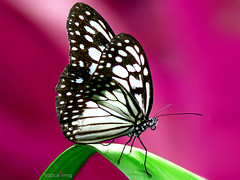When you take a picture of something small, like a flower or an insect, you'll try to get as close as possible to the subject in order to make it fill the frame. But with most lenses, you'll run into a problem--when you're too close to the subject, you won't be able to get your camera lens to focus on it. The lens has a "minimum focusing distance", a minimum distance that you have to stand from the subject in order to properly focus on it.
In general, shorter focal length lenses will allow you to get closer to the subject.
The minimum focusing distance for a lens is printed on the barrel next to a little flower icon.
Here are the distances for our three current lenses.
Our Canon 18-55mm f/3.5-5.6 zoom lens will focus as close as 11 inches.

Our Canon 50mm f/1.8 lens is a little farther out at 18 inches.

Our Canon 55-200mm f/4.5-5.6 zoom lens can't get any closer than 48 inches (4 feet).

Ok, great, but wait a second... A shorter focal length will allow me to stand closer, but what really matters is that I fill the frame, and a longer focal length will let me zoom in more! So which one's really better? Which one is going to allow me to get more of the subject in my frame?
I decided to do some tests. I would have loved to be more scientific and accurate about these, but then the post would never have gotten done. Maybe I'll revisit this some day when I understand the underlying mechanics better. I think the results are still pretty valuable and pretty conclusive, though.
We took a walk this morning up to the Santa Barbara mission. The mission has some beautiful rose gardens that I was hoping to use as my test subjects. Sadly, they're pruned down right now and there were no pretty flowers in sight!
Determined to get my tests done, though, I picked a piece of wood on the side of a bench with a chip in it and shot away.
The zoom lenses have only one minimum focusing distance written on them, so I've been wondering, does that mean that the distance doesn't change with the zoom, or does the value only apply when the lens is at its minimum focal length? I would have expected the latter, but the results surprised me.
Here's how I took the photos. For each lens, I'd turn the focus ring all the way to focus as close as possible, and then I would move the camera closer or farther away from the bench until it came into focus. Once it was in focus, I measured the distance from the wood to the camera body with a tape measure. I had planned to use a tripod, but it would have taken forever, and I don't think the measurements needed to be very accurate here to prove the point. Here's what I measured.
18-55mm zoom
Printed distance: 11"
Measured distance at 18mm: ~7.5"
Measured distance at 55mm: ~7.5"
50mm fixed
Printed distance: 18"
Measured distance at 50mm: ~15.5"
55-200mm zoom
Printed distance: 48"
Measured distance at 55mm: ~45"
Measured distance at 200mm: ~45"
So for a zoom lens, the amount of zoom doesn't affect the distance!
Now, distance aside, which setup allowed me to fill the frame with the subject the most? Here are the photos, from largest to smallest. These are all un-cropped so you can see the difference.
1. 18-55mm lens at 55mm

2. 55mm-200mm zoom lens at 200mm


3. 50mm lens


4. 18-55mm zoom lens at 18mm


5. 55-200mm zoom lens at 55mm


Those results are pretty surprising! With a 200mm zoom lens, I had to stand four feet from the bench, but I was still able to frame it tighter than with a 50mm lens only a foot away. So really, the zoom factor plays almost as large of a role in filling the frame as does the minimum focusing distance. I say "almost" because the 55mm zoom, with it's smaller focusing distance, took the number one spot, but just barely.
Of course, standing farther back with a larger zoom meant that camera shake was more of a problem. At a larger zoom, small movements of the camera are going to translate into bigger movements of the frame, so in that regard it's better to get as close as possible to the subject. It's interesting to know, though, that if you can't get close to a subject, you can still do well with a large zoom.
Before we finish here, I'm sure a lot of people would point out that I'm using the wrong equipment for photographing small objects. I can do pretty well with the standard equipment I have here, but for really small subjects there's a field of photography called "Macro Photography". Technically, a "macro" lens is one that makes the subject at least as large on the film or image sensor as it is in real life. So if you took a picture of a 3cm long cricket on some 35mm film with a 1:1 macro lens, you would have an image where the cricket filled almost the entire frame. Macro lenses are a subject for another post, I think.
So here are what I think are the highlights of what I've learned:
- Zoom does not affect the minimum focusing distance, so zoom in!
- Zoom fills the frame almost as well as being close to the image, so don't give up just because you can't get close. You'll just need a steady hand or a tripod.

